PuzzleFixer: A Visual Reassembly System for Immersive Fragments Restoration
Shuainan Ye, Zhutian Chen, Xiangtong Chu, Kang Li, Juntong Luo, Yi Li, Guohua Geng, Yingcai Wu
View presentation:2022-10-19T19:24:00ZGMT-0600Change your timezone on the schedule page
2022-10-19T19:24:00Z

Prerecorded Talk
The live footage of the talk, including the Q&A, can be viewed on the session page, Immersive Analytics and Situated Visualization.
Fast forward
Abstract
We present PuzzleFixer, an immersive interactive system for experts to rectify defective reassembled 3D objects. Reassembling the fragments of a broken object to restore its original state is the prerequisite of many analytical tasks such as cultural relics analysis and forensics reasoning. While existing computer-aided methods can automatically reassemble fragments, they often derive incorrect objects due to the complex and ambiguous fragment shapes. Thus, experts usually need to refine the object manually. Prior advances in immersive technologies provide benefits for realistic perception and direct interactions to visualize and interact with 3D fragments. However, few studies have investigated the reassembled object refinement. The specific challenges include: 1) the fragment combination set is too large to determine the correct matches, and 2) the geometry of the fragments is too complex to align them properly. To tackle the first challenge, PuzzleFixer leverages dimensionality reduction and clustering techniques, allowing users to review possible match categories, select the matches with reasonable shapes, and drill down to shapes to correct the corresponding faces. For the second challenge, PuzzleFixer embeds the object with node-link networks to augment the perception of match relations. Specifically, it instantly visualizes matches with graph edges and provides force feedback to facilitate the efficiency of alignment interactions. To demonstrate the effectiveness of PuzzleFixer, we conducted an expert evaluation based on two cases on real-world artifacts and collected feedback through post-study interviews. The results suggest that our system is suitable and efficient for experts to refine incorrect reassembled objects.